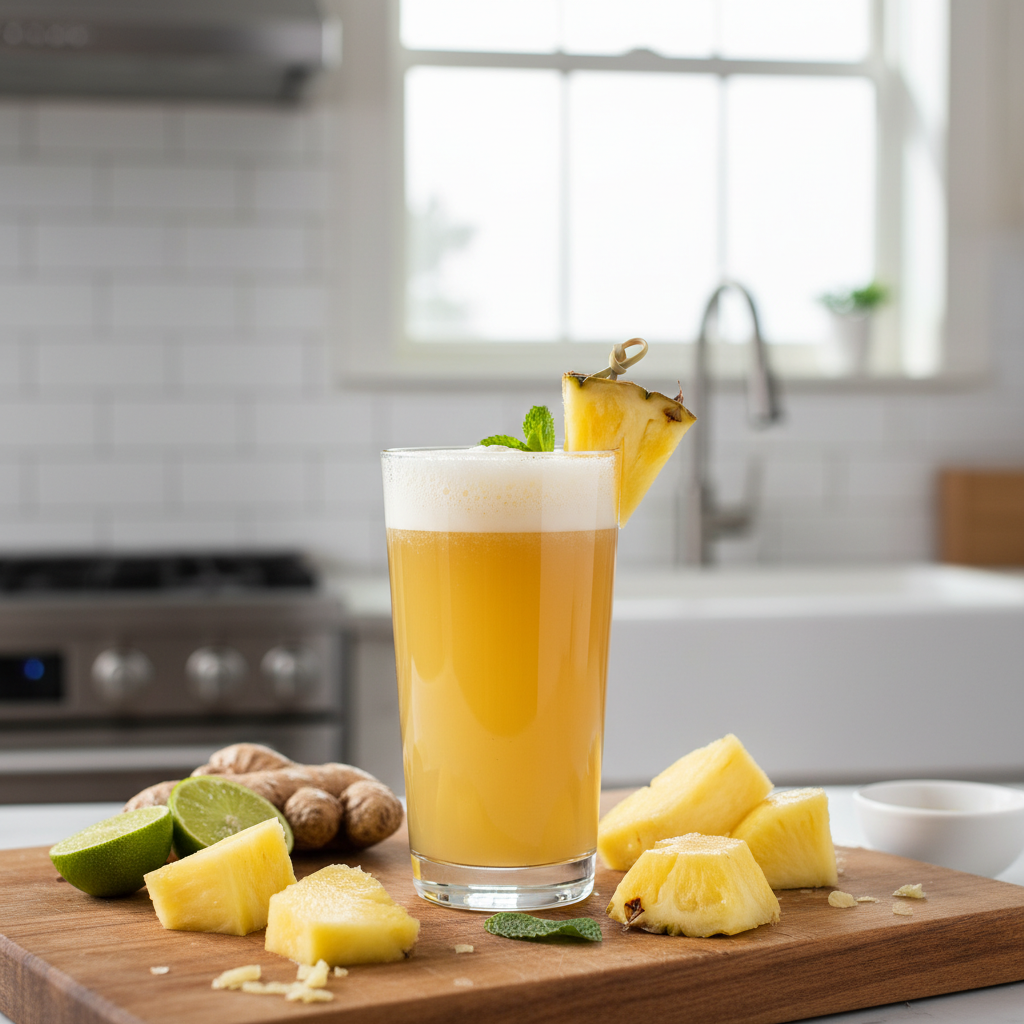Ever find yourself staring at a perfectly good pineapple core after you’ve sliced up the juicy fruit, wondering if there’s *any* use for it beyond the compost bin? I know I used to! For years, those fibrous, sometimes tough centers went straight into the trash, a silent testament to kitchen waste. But what if I told you that those often-discarded cores are actually packed with flavor and nutrients, just waiting to be unleashed into a refreshing, health-boosting juice? Get ready to say goodbye to food waste and hello to your new favorite homemade drink: pineapple core juice!
It’s not just about being thrifty; it’s about unlocking hidden deliciousness and embracing a more sustainable way of living. This isn’t some bland, watery concoction; it’s a surprisingly sweet, slightly tangy, and incredibly satisfying beverage that will make you rethink everything you thought you knew about pineapple preparation. So, grab your leftover cores, and let’s turn “waste” into wonderful!
My Journey to Juicing the Core: A Personal Revelation
My journey to making pineapple core juice started out of pure curiosity and a touch of guilt. I love pineapples – their tropical sweetness always brightens my day. But the sheer amount of the core I was throwing away after preparing a whole pineapple always nagged at me. It felt wrong, like I was discarding a significant part of a perfectly good fruit. I’d seen online posts about using vegetable scraps for broth or fruit peels for infusions, and a little lightbulb went off: what about the pineapple core?
My first attempt was tentative. I chopped up the core, boiled it with some water, and then strained it, half expecting a bitter, unpleasant result. To my absolute astonishment, what I poured into my glass was a lightly golden liquid with a subtle, yet distinctly pineapple-y flavor. It wasn’t as intensely sweet as juice made from the flesh, but it had a delightful tang and an earthy depth that was incredibly refreshing. It felt like I’d uncovered a secret. From that day on, my pineapple core consumption went from zero to 100%, and my kitchen waste bin breathed a sigh of relief. It truly transformed my perspective on food scraps and encouraged me to look for other hidden gems in my kitchen!
Why Pineapple Cores Deserve a Second Chance
Beyond the satisfaction of reducing waste, there are some fantastic reasons why pineapple cores should be on your juicing radar. It’s not just a “filler” ingredient; it’s a powerhouse!
Nutritional Boosters Hiding in Plain Sight
- Bromelain Power: The core is actually the most concentrated source of bromelain, a powerful enzyme unique to pineapples. Bromelain is celebrated for its anti-inflammatory properties, making it great for reducing swelling and aiding digestion. It’s often used as a natural remedy for joint pain and recovery after intense exercise.
- Fiber Rich: While juicing removes some of the insoluble fiber, you still get beneficial soluble fiber in the core, which is good for gut health and can help regulate blood sugar.
- Antioxidants Galore: Pineapples, including their cores, are rich in Vitamin C and other antioxidants that help fight off free radicals in your body, supporting overall health and immunity.
- Hydration Hero: Like the rest of the pineapple, the core has a high water content, contributing to hydration, especially on a hot day.
So, instead of seeing a tough, inedible part, start seeing a concentrated dose of wellness waiting to be extracted!
Crafting Your Perfect Pineapple Core Juice: The Simple Recipe
Don’t be intimidated by the idea of making juice from a core. It’s surprisingly simple, requires minimal equipment, and the results are incredibly rewarding. Here’s how I make my go-to pineapple core juice:
What You’ll Need:
- Pineapple Cores: From 1-2 medium pineapples (adjust quantity based on how much juice you want).
- Water: About 4-6 cups for 1-2 cores, depending on desired concentration.
- Optional Sweeteners: A tablespoon or two of honey, maple syrup, or agave (to taste).
- Optional Flavor Boosters: A thumb-sized piece of fresh ginger (peeled and sliced), a pinch of turmeric, a few mint leaves, or a squeeze of lime/lemon juice.
Essential Equipment:
- Large saucepan
- Fine-mesh sieve or cheesecloth
- Blender (optional, if you prefer a raw, thicker juice)
- Container for storage
Step-by-Step Guide:
- Prep Your Cores: First, ensure your pineapple is well-washed before you cut it. Once you’ve removed the flesh, take the remaining core and give it another quick rinse. Chop the core into smaller, roughly 1-inch pieces. This increases the surface area for extraction and makes it easier to handle.
- The Gentle Boil (My Preferred Method): Place your chopped pineapple cores into a large saucepan. Add enough water to generously cover the cores, usually about 4-6 cups for the core of one large pineapple. Bring the mixture to a boil, then immediately reduce the heat to a simmer. Let it simmer gently for 20-30 minutes. You’ll notice the water starting to take on a pale yellow hue and a subtle pineapple aroma filling your kitchen. This gentle simmering helps to soften the core and release its precious juices and nutrients without overcooking.
- Cool Down: Turn off the heat and let the mixture cool down completely in the saucepan. This step is crucial because it allows for further flavor infusion as the cores sit in the warm liquid, and it also makes straining safer and easier.
- Strain the Magic: Once cooled, pour the entire contents of the saucepan through a fine-mesh sieve into a large bowl or directly into your serving pitcher. Use the back of a spoon to press down on the cooked core pieces in the sieve to extract as much liquid as possible. If you want an even clearer juice, you can line your sieve with a couple of layers of cheesecloth.
- Flavor and Sweeten (Optional but Recommended!): Now’s the fun part! Taste your juice. It will be subtly pineapple-y and slightly tart. If you like it sweeter, stir in a tablespoon or two of honey, maple syrup, or agave until it reaches your desired sweetness. This is also where you can add your flavor boosters. If you’re using fresh ginger, you can grate a little into the strained juice, or for a stronger kick, you could have simmered it with the cores. A squeeze of lime or lemon brightens the flavor beautifully, and a few mint leaves can add a wonderful freshness.
- Chill and Serve: Transfer your glorious pineapple core juice to a pitcher or bottle and chill it thoroughly in the refrigerator. It tastes best when served cold, perhaps over ice.
A Note on Blending: If you prefer a thicker, raw juice and have a powerful blender, you can blend the raw, chopped cores with a minimal amount of water, then strain. However, I find the boiling method more effective for extracting flavor and nutrients from the tough core, and it’s more accessible for those without high-powered juicers.
Beyond the Core: Creative Twists and Pairings
Now that you’ve mastered the basic pineapple core juice, let’s get creative! This juice is incredibly versatile:
- Ginger & Turmeric Boost: For an anti-inflammatory powerhouse, add fresh ginger slices and a pinch of ground turmeric (or a small piece of fresh turmeric root) to the pot while simmering.
- Minty Fresh: Muddle a few fresh mint leaves into your chilled juice for an invigorating twist, perfect for summer.
- Citrus Zing: A generous squeeze of lime or lemon juice after straining elevates the flavor profile, making it brighter and more refreshing.
- Sparkling Delight: Mix your pineapple core juice with sparkling water or club soda for a healthy, bubbly beverage.
- Smoothie Base: Use it as the liquid base for your morning smoothies instead of plain water or other juices.
- Cocktail/Mocktail Mixer: It makes a fantastic, unique mixer for tropical cocktails or sophisticated mocktails. Imagine a pineapple core mojito or margarita!
- Marinade Magic: The bromelain in pineapple is a natural tenderizer. Use the juice as a base for marinades for chicken, pork, or tofu.
Don’t be afraid to experiment! The beauty of homemade creations is that you can tailor them exactly to your taste.
The Zero-Waste Kitchen: A Mindset Shift
Making pineapple core juice isn’t just about a single recipe; it’s a stepping stone towards a more mindful and sustainable kitchen. Every time I prepare this juice, I feel a quiet sense of accomplishment. It reminds me that often, what we perceive as “waste” is simply a resource we haven’t yet learned to utilize.
Embracing a zero-waste mindset encourages you to look at every part of your ingredients differently. Carrot tops can become pesto, broccoli stems can be roasted, and citrus peels can be candied or infused. It’s a journey of discovery that not only benefits the environment by reducing landfill waste but also often unlocks new flavors and textures you might never have experienced. Plus, it saves money – why buy another expensive juice when you can make a delicious one from something you’d otherwise throw away?
This simple act of juicing a core is a small but significant step towards a larger goal: a kitchen that’s more efficient, more flavorful, and more respectful of the planet’s resources. It’s about recognizing value where you once saw none.
Conclusion
So, the next time you’re wielding a knife, expertly slicing off that tough, fibrous pineapple core, pause. Don’t let it become another casualty of the kitchen bin. Instead, remember the hidden potential within – the vibrant flavor, the nutritional benefits, and the satisfaction of contributing to a zero-waste lifestyle. With minimal effort, you can transform it into a delicious, healthy, and incredibly refreshing pineapple core juice that will surprise and delight you.
It’s a simple recipe that delivers big on taste, health, and sustainability. Give it a try! You might just find that this “waste” product becomes one of your favorite kitchen treasures. Happy juicing!




